17
Invisalign®: as Many Answers as Questions
Is Invisalign® new?
How does Invisalign work?
What are the pre-treatment considerations?
How does the Invisalign System differ from conventional orthodontics?
What characterizes patients seeking Invisalign treatment?
What is the most favourable approach to resolving crowding in Invisalign patients?
How can the alternatives to IER be evaluated?
What are the problems related to resolution of crowding?
When are extractions indicated?
Does an Invisalign treatment plan differ from a regular orthodontic treatment plan?
How does one take an adequate impression for the Invisalign System?
What is required to be evaluated in ClinCheck®?
What material are aligners made of?
What are aligner attachments?
How are attachments fabricated on the teeth?
What has to be controlled after insertion of aligners?
What are the consequences of good or poor aligner fit?
What if an aligner is lost?
What can be done if a severe discrepancy between ClinCheck® and the clinical situation becomes evident during treatment?
What can be done if a slight discrepancy between ClinCheck® and the clinical situation becomes evident at the end of treatment?
How can complications during treatment with the Invisalign System be avoided?
References
Is Invisalign® New?
Yes and no! As early as in 1945, Kesling wrote: ‘Major tooth movements could be accomplished with a series of Positioners by changing the teeth on the setup slightly as treatment progresses.’ From 1971 onwards, several publications on clear appliances appeared. These appliances were mainly used as retainers because, as active appliances, they lacked precision and required too much work to move teeth into the desired positions (Ponitz 1971; McNamara et al. 1985; Sheridan et al. 1993; Rinchuse and Rinchuse 1997).
With the computer-aided design/computer-aided manufacture (CAD/CAM)-based Invisalign System introduced in 1997, the idea of moving teeth with clear plastic appliances took a new turn.
How Does Invisalign Work?
The present text reflects the state of the art in technology and therapeutic possibilities at the time of writing (2006). Align Technology is continuously developing novel methods to improve the process. Each treatment is based on a complete set of records including extra- and intraoral photographs, full X-ray status, vinyl polysiloxane impressions of the dental arches including the alveolar processes and an exact bite registration.
The impressions are scanned by a computed tomography (CT) scanner while rotating in front of an amorphous silicon X-ray sensor. From the database a set of virtual models is generated. The precision of the scanning process is around 100 µm (Lee et al. 2002). Eventual artefacts are corrected by a process of tooth shaping based on the operator’s knowledge of tooth anatomy and the patient’s photographs.
The occlusion is established based on the bite registration supplemented by the photographs, and a software program for collision control. In addition, the gingival sulcus is marked and a virtual gingiva is draped over the alveolar processes. This serves to define the margin of the aligners during manufacturing and to allow a more realistic visual presentation (Fig. 17.1). Proprietary design software (Treat) subsequently enables the operator to separate the crowns of all teeth from each other (Beers et al. 2003).
Fig. 17.1 Virtual models of a patient with bimaxillary crowding that was corrected by extraction of all four 2nd premolars. Since the patient was an airline attendant she refused treatment with fixed appliances and was treated with the Invisalign System only; compare with Fig. 17.6.
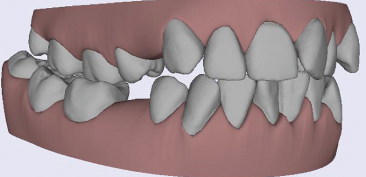
Every individual tooth is checked for scanning artefacts by comparing it with the existing intraoral photographs, considering normal tooth anatomy. This process is called ‘tooth shaping’. In a subsequent operation termed ‘staging’, the software technician defines specific landmarks on the enamel surface to construct reference lines, e.g. the facial crown axis. The technician will then rearrange all the teeth according to the treatment plan submitted by the orthodontist and determine the sequence by which the individual teeth should be moved (Miller and Derakhshan 2002).
The two basic approaches are:
- Simultaneous movement of a group of teeth, called X-pattern due to its graphic representation
- Sequential movement of individual teeth as typically in a situation in which posterior teeth are distalized and where the movement of the second molars is followed by the first molars, the second premolars etc., named Y-pattern due to its graphic representation.
During all the movements, occlusal or interproximal interferences should be avoided. Within each stage, the movement can be variously programmed between 0.10 and 0.33 mm. Depending on the complexity of the malocclusion, the sequence and the velocity of movements, the number of necessary aligners required can reach 70 or even more.
After being prepared in the Align laboratory, the virtual model is sent to the clinician, who can assess the treatment with an animation program called ‘ClinCheck®’. If both clinician and the patient find the simulation satisfactory, the clinician clicks ‘accept’ to let the company know. Patients generally appreciate active participation in their therapy.
Once the treatment goal has been accepted, Align Technology will transfer the virtual model into a physical resin model using a stereolithographic method (Fig. 17.2). During stereolithography, a laser cures liquid polymer by photoactivation. The cleaned and refined acrylic models will then be loaded into an automat that heats, pressure forms and laser marks all the raw aligners, which are then transferred to a cutting automat. This machine will trim aligners after which they all are separated from the stereolithographic model, polished, disinfected, packaged and finally shipped to the respective doctor (Wong 2002; Kuo and Miller 2003) (Fig. 17.2).
Fig. 17.2 (1) Refined stereolithographically produced resin model of a specific treatment stage, which serves as a working cast to produce the respective aligner. All of the discernible resin layers are about 0.15 mm thick. (2) Finished aligner made of clear polyurethane with occlusal labelling (patient number, upper/lower jaw, and aligner stage number).
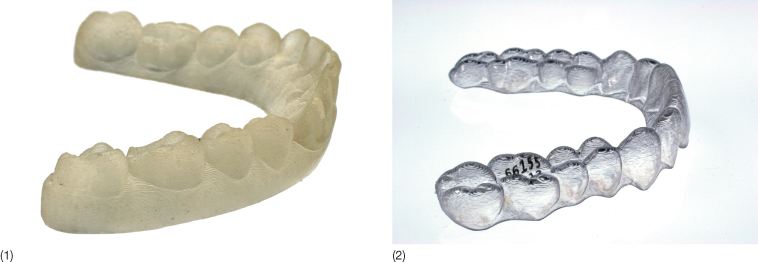
What Are the Pre-Treatment Considerations?
Patients frequently arrive in an orthodontic office with the request to be treated with an invisible appliance. In this situation, they can be offered lingual appliances or Invisalign therapy. Principally, Invisalign therapy is orthodontics with just a different appliance system. Therefore, consultation, record collection, documentation of existing problems and treatment goals should follow standard orthodontic operational procedures. Align Technology requests the following records:
- Photographs (extraoral: frontal (at rest/smiling) and profile; intraoral: frontal, left/right lateral, maxillary/mandibular occlusal)
- Radiographs (panoramic or periapical, optional: cephalogram)
- Vinyl polysiloxane impressions (maxillary, mandibular) plus bite registration
- Completed treatment form.
Other than the impressions, everything else can be submitted as high-resolution records via e-mail.
How Does the Invisalign System Differ from Conventional Orthodontics?
One of the biggest differences is that Invisalign treatment has to be planned from the first to the last movement in all possible details. In contrast to most other treatment modalities, the sequence, the direction and the amount of any tooth movement can only be changed by a midcourse correction (see ‘What can be done if during treatment a severe discrepancy between ClinCheck® and the clinical situation becomes evident?’), which implies additional costs and a delay of progress. This may seem to be disadvantageous, but can also be considered a challenge. The visualization of the anticipated outcome is helpful. Such visualization can be accomplished by using occlusograms (Melsen 2012), a standard study model set-up, or, as in the case of Invisalign, by a virtual set-up.
What Characterizes Patients Seeking Invisalign Treatment?
The chief complaint of patients choosing treatment with the Invisalign System includes crowding or spacing, flaring, supra- or infra-erupted teeth (Vlaskalic and Boyd 2001; Meier et al. 2003) (Fig. 17.3). Spacing and flaring can generally be resolved without problems and intrusion of over-erupted teeth is not a problem as long as the aligners are not dislodged occlusally from the anchor teeth. Retention can be easily improved by adding so-called attachments to the neighbouring teeth. Since extrusion of infra-erupted teeth cannot be predictably accomplished with the Invisalign System alone it may require additional measures (see ‘How can complications during treatment with the Invisalign System be avoided?’). Crowding can be treated by: interproximal enamel reduction (IER), expansion of the dental arch, moving posterior teeth distally or with extractions.
Fig. 17.3 Frequency of occurrence of various malocclusion features in patients enquiring about Invisalign therapy
(data source: Meier et al. 2003).
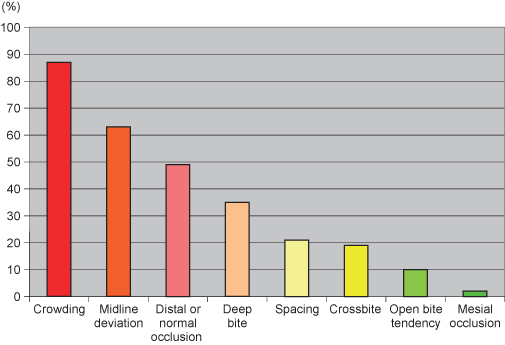
What Is the Most Favourable Approach to Resolving Crowding in Invisalign Patients?
Crowding is most frequently resolved by IER, primarily because many Invisalign patients had orthodontic treatment previously, specially if the crowding is only moderate (Miethke and Jost-Brinkmann 2006) (Fig. 17.4). Extractions would create excessive space and IER is effective in avoiding open gingival embrasures (Atherton 1970; de Harfin 2000; Kurth and Kokich 2001; Zachrisson 2004), a problem which increases with age especially in patients with advanced periodontal diseases. IER is also the treatment of choice in the case of a tooth size discrepancy between the two dental arches.
Fig. 17.4 (1) Patient in whom interproximal enamel reduction (IER) was performed before treatment to alleviate crowding; only very limited tooth movements will be required and no excessive space will remain if the procedure is carried out with due care. (2) Patient with a Class II Division 1 malocclusion in whom distal movement of the maxillary posterior teeth was indicated. To overcome the reactive protrusive force on the maxillary anterior teeth the patient wore Class II elastics, which had the positive side effect of facilitating correction of the distal occlusion.

Fundamentally, IER is an imitation of a physiological process because extensive attrition was a feature of the natural human dentition before civilization led to consumption of increasingly soft food.
How Can the Alternatives to IER Be Evaluated?
An alternative to IER is transverse expansion of the dental arch. However, only 3–4 mm space can be generated and expansion may be unstable (Chenin et al. 2003). This applies especially to the mandible where crowding is most frequently seen. Still, expansion may be indicated as a wider dental arch avoids the appearance of dark buccal corridors while smiling (Sarver 2001; Womack et al. 2002; Sarver and Ackerman 2003, Moore et al. 2005).
Another alternative to IER would be to move posterior teeth distally to create space for the anterior segment. This approach too is limited to 3–4 mm space gain. Distal movements can be enhanced by separating the posterior teeth before the vinyl polysiloxane impressions are taken. The preceding separation guarantees a much better fit of the aligners, especially in the interproximal spaces. The fit can be enhanced further by applying so-called attachments on the teeth to be moved distally. Since the laws of equilibrium cannot be overlooked, any retrusion of posterior teeth will produce some reciprocal protrusion of the anterior segments. Therefore, it is advisable to use appropriate interarch elastics simultaneously (Fig. 17.4); also the orthodontist should take care that all distal movements are programmed sequentially.
Besides the above-mentioned limitation, a problem related to lengthening of the dental arch is that it is time consuming to gain the necessary space before the crowding of the anterior segment can be alleviated. This may adversely impact on the patient’s cooperation.
Since extraction therapy with Invisalign treatment is still controversial, it will be dealt with in a separate section below.
What Are the Problems Related to Resolution of Crowding?
The malocclusion features related to crowding are labiolingual malpositions, rotations and deviations from normal angulation. Positional irregularities do not create any difficulties as correction usually only requires tipping or small bodily movements.
While rotations of relatively flat teeth such as incisors do not pose a problem, rotation of relatively cylindrical teeth as canines and premolars cannot generally be resolved with standard aligners. Any aligner which is programmed to derotate one of those teeth by no more than 2° will only contact the tooth surface in a few spots and most likely deliver more vertical than rotational forces (Fig. 17.5). Rotation of molars is also a problem due to resistance by the root surface to such a movement.
Fig. 17.5 (1) Graphic representation of the fit between tooth and aligner. If the tooth is rotated 15° anticlockwise the aligner (white mesh) contacts the enamel only in the areas indicated by the red arrows, whereas is stands away from the remaining tooth surfaces. Please notice that the average rotation programmed by Align is between 2–5°, which results into a mean 0.2 mm movement of the distal/mesial proximal surface depending on the mesiodistal width of the respective tooth. (2) The result of the imperfect fit is a premature contact which could eventually lead to a completely different movement (intrusion) than originally intended (rotation); notice the extensive void areas between the aligner (white mesh) and the tooth.
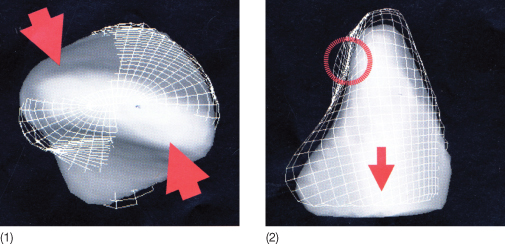
Correction of angulations may also be a problem. It is easy to envision that it is difficult for an aligner with its smooth surface to move a tooth with a likewise smooth surface and hardly any natural undercuts. This problem can be overcome by bonding rectangular attachments to the respective teeth.
When Are Extractions Indicated?
Since basic orthodontic principles also apply to Invisalign, indications for extractions are no different for these treatments. When extractions of premolars (Fig. 17.6) are indicated, although such extraction spaces could be closed with aligners, paralleling the roots of all teeth would be difficult, especially in a mandibular arch with a deep curve of Spee.
Fig. 17.6 Same patient as depicted in Figure 17.1; occlusal and lateral views before (1–4) and after treatment (5–8) involving extraction of maxillary first and mandibular second premolars; 46 aligners were used in the maxilla and 49 in the mandible. The result is satisfactory apart from some mesial tipping of the molars. This may be improved during case refinement, which would require additional aligners manufactured using either original or new impressions.
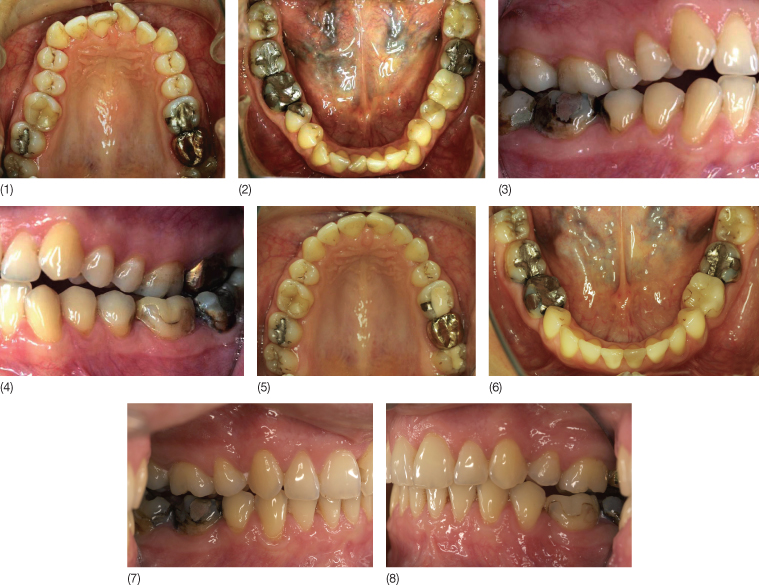
Extraction of mandibular incisors is only indicated if the lack of space exceeds 5.0 mm. It may be difficult to parallel the roots, and a midline discrepancy between the two dental arches will remain (Fig. 17.6). The main objection to extractions, especially in adult patients with a certain degree of gingival recession, is that removal of teeth will almost inevitably lead to open gingival embrasures (Fig. 17.6). Extractions should be considered as the last choice for resolution of crowding during therapy with the Invisalign System, and such treatment may require the use of appropriate attachments and even specific adjuncts (Miller et al. 2002).
Fig. 17.6 (9,10) Patient in whom the mandibular right central incisor and the maxillary first premolars were extracted because of severe crowding. Note that already before treatment the periodontal condition of the mandibular left central and right lateral incisors was compromised. At the end of the first phase of Invisalign treatment and before case refinement the periodontal situation has deteriorated although a free gingival graft was performed. (11,12) Patient in whom the mandibular right central incisor was extracted because of the existing crowding and a rather favourable angulation of the remaining front teeth. The result was to the patient’s satisfaction; however, the reduction of vertical overbite could be criticized and even more so the open gingival embrasures. These were already existing but not visible at the beginning of treatment as the interproximal spaces were filled with calculus.
Stay updated, free dental videos. Join our Telegram channel

VIDEdental - Online dental courses


